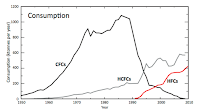This week, countries will gather in Kigali, the capital city of Rwanda, to tackle a small but potent cause of climate change: hydrofluorocarbons (HFCs).
The conference is the second in a trio of important UN climate meetings this year. Earlier in October, nations worked on a new aviation deal. In November, they will convene again in Marrakech to build on the Paris Agreement.
HFCs are synthetic chemicals used mainly in fridges and air conditioning, but also in fire extinguishers and as solvents.
HFCs, like aviation and shipping, were omitted from the Paris Agreement, despite being a potent greenhouse gas. Countries have agreed to tackle them them through the Montreal Protocol instead — a UN treaty better known for tackling the hole in the ozone layer by phasing out chlorofluorocarbons (CFCs).
Why are HFCs important?
The Montreal Protocol is recognized as one of the UN’s most successful environmental treaties to date. It called for a total phase out of CFCs by 1995 for developed countries and 2010 for developing countries.
However, these CFCs had to be replaced by something. At first, this was hydrochlorofluorocarbons (HCFCs) — a group of chemicals that deplete the ozone layer 10 to 50 times less than CFCs, which were considered “transitional substitutes” under the Protocol until ozone-safe replacements could be commercialized.
Later, HFCs started to be used instead. The graph above illustrates the rise and fall in the use of these three chemicals.
Scientists estimate that HFCs in the atmosphere account for 1% of the warming caused by all greenhouse gases, but their usage is on the rise. Consumption is growing at a rate of 10-15% a year, as demand grows for fridges and aircon. One study estimates that, in a business-as-usual scenario, HFCs could rise to 9-19% of projected global emissions by 2050.
This is problematic because of their impact on the climate. While emissions are dwarfed against global CO2 emissions, their capacity to warm the atmosphere is stronger.
There are several different types of HFCs. The most persistent ones can be several thousand times better at absorbing heat than CO2. Based on the current mix of HFCs being used, their impact is 1,600 times stronger than CO2 per tonne emitted.
One study has argued that phasing out HFCs could help to avoid up to 0.5C of warming by the end of the century. Since the Paris Agreement has an aspirational but difficult goal of limiting warming to 1.5C above pre-industrial levels, such a boost could prove vital.
Read more at Explainer: Why a UN Climate Deal on HFCs Matters

No comments:
Post a Comment